Building a SATA to eSATA panel harness requires careful attention to shielding and grounding to ensure optimal performance. This guide covers practical shield-drain wiring strategies for DIY setups.

SATA vs eSATA Basics
- SATA cables are thin internal cables with twisted data pairs.
- eSATA cables feature a metal foil or braided shield for enhanced protection in outdoor use.
- eSATA plugs are mechanically different and deeper to prevent unshielded cables from blocking.
- The eSATA cable carries the same signals but with extra shielding and ground lines.
When routing a cable outside the case, use a proper shielded eSATA cable or wrap a SATA cable with metal to reduce EMI.
Shield and Drain Concepts
A shield is a metal foil or braid around the cable that blocks interference. The drain wire is a bare conductor bonded to that shield. The drain safely grounds any stray noise.
Think of the drain as a safety path for noise and static, protecting the data lines.
Because the drain is thin, ground it at only one end (usually the panel side) to avoid loops.
Grounding the Panel Harness
- The eSATA port’s metal shell should be screwed to the computer chassis as part of the case ground.
- Mount the bracket firmly on the case with screws or clips for solid metal-to-metal contact.
- Attach the cable’s drain wire or shield braid to the bracket or connector shell, tying the shield into chassis ground.
This grounds the cable shield at the panel end, giving a path to earth while the drive end stays isolated. Grounding only at the panel avoids a loop but still provides noise protection.
Wiring Tips and Tricks
- Use a metal eSATA bracket that screws into the case. This ensures a solid chassis ground.
- If using a plain SATA cable, wrap it in aluminum foil or braid and attach that to the bracket.
- Connect the drain wire (if present) to the bracket’s ground. If there is no drain, press the shield braid against the metal contact.
- Ground only at the panel end. Leave the cable’s far end floating to avoid a ground loop.
- Inspect connections to ensure metal-to-metal contact (without paint or coating) for grounding.
Common Questions
A: eSATA cables include shielding to meet EMI/ESD standards. A regular SATA cable may work for short runs, but for safety, use a shielded eSATA cable. Alternatively, wrap a regular SATA cable with metal if it will run outside the case.
A: Tie the drain wire to the chassis at the panel end. Usually, connect it under the same screw or lug that holds the bracket in place. This gives the shield a ground path without connecting it to the internal device.
A: Plastic brackets can’t ground by themselves. Use a metal bracket or run a separate wire from the cable shield to a metal point on the chassis.
Real-World Setup Example
- Imagine adding an eSATA port to a desktop: you need an internal bracket with an eSATA connector.
- Plug a shielded eSATA cable from the motherboard’s SATA header to that bracket.
- Mount the bracket so its metal shell is screwed tightly to the case; this grounds the cable shield to the chassis.
- With that one-ended grounding in place, you can safely hot-swap an external drive.
The shield and grounding keep interference low, preserving signal integrity on the high-speed link.
✦ Looking for precision-engineered cable assemblies?
Romtronic specializes in custom SATA/eSATA panel harnesses, shielded cables, and advanced wiring solutions that meet the highest industry standards. Our team ensures every assembly is built for performance, durability, and compliance.
👉 Talk to our experts today →
Conclusion
A well-designed SATA-to-eSATA panel harness requires more than just connecting data pins—it depends heavily on a proper shield, drain, and ground strategy. By grounding the shield at the chassis side and maintaining clean, short connections, you can achieve stable performance and minimize EMI issues.
With these tips, the panel harness will run quietly and safely. Happy hacking and data-transferring!
.avif)
Sam Wu is the Marketing Manager at Romtronic, holding a degree in Mechatronics. With 12 years of experience in sales within the electronic wiring harness industry, he manages marketing efforts across Europe. An expert in cable assembly, wiring harnesses, and advanced connectivity solutions, Sam simplifies complex technologies, offering clear, actionable advice to help you confidently navigate your electrical projects.


